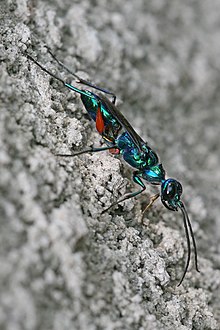
Apocrita is a suborder of insects in the order Hymenoptera. It includes wasps, bees, and ants, and consists of many families. It contains the most advanced hymenopterans and is distinguished from Symphyta by the narrow "waist" (petiole) formed between the first two segments of the actual abdomen; the first abdominal segment is fused to the thorax, and is called the propodeum. Therefore, it is general practice, when discussing the body of an apocritan in a technical sense, to refer to the mesosoma and metasoma rather than the "thorax" and "abdomen", respectively. The evolution of a constricted waist was an important adaption for the parasitoid lifestyle of the ancestral apocritan, allowing more maneuverability of the female's ovipositor. The ovipositor either extends freely or is retracted, and may be developed into a stinger for both defense and paralyzing prey. Larvae are legless and blind, and either feed inside a host or in a nest cell provisioned by their mothers.
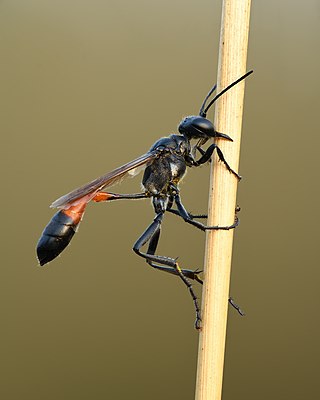
The Sphecidae are a cosmopolitan family of wasps of the suborder Apocrita that includes sand wasps, mud daubers, and other thread-waisted wasps.

The emerald cockroach wasp or jewel wasp is a solitary wasp of the family Ampulicidae. It is known for its unusual reproductive behavior, which involves stinging a cockroach and using it as a host for its larvae. It thus belongs to the entomophagous parasites.

The subfamily Crabroninae(digger wasps) is the most diverse group in the wasp family Crabronidae, containing over 110 genera and 4,800 described species. The subfamily consists of solitary, predatory wasps. The adult females of many groups dig tunnels in the ground for nesting, but others use different techniques, including the construction of tube-like mud nests.
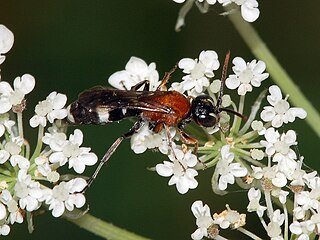
Gorytini is a large and morphologically very diverse group of hunting wasps distributed worldwide and particularly species-rich in tropical areas. Most species hunt various hemipterans, especially among the Auchenorrhyncha, which they sting, paralyze, and provision in underground nests as food for their larvae.

Crabronini is a tribe of square-headed wasps in the family Crabronidae. There are 48 genera and over 1,500 described species in Crabronini. Wasps of this tribe are mostly small to very small wasps. Typical of this tribe are the forewings with a single submarginal cell, the lack of membranous metanotal and propodeal modifications, and a square-shaped head.

Sphex ichneumoneus, known commonly as the great golden digger wasp or great golden sand digger is a wasp in the family Sphecidae. It is identified by the golden pubescence on its head and thorax, its reddish orange legs, and partly reddish orange body. This wasp is native to the Western Hemisphere, from Canada to South America, and provisions its young with various types of paralyzed Orthoptera.
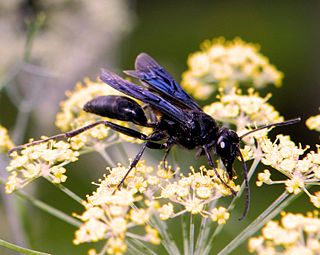
Sphex pensylvanicus, the great black wasp, is a species of digger wasp. It lives across most of North America and grows to a size of 20–35 mm (0.8–1.4 in). The larvae feed on living insects that the females paralyze and carry to the underground nest.
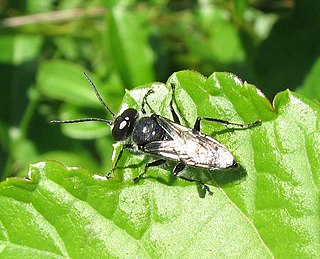
Astata is a cosmopolitan genus of solitary predatory wasps in the subfamily Astatinae. They are known to prey on adults and nymphs of Pentatomidae. Astata is the largest genus in this subfamily, and is identified by features of its wing venation. The males of this genus and the related genus Dryudella have very large compound eyes that broadly meet at the top of the head.

Sphecius grandis, also called the western cicada killer, is a species of cicada killer wasp (Sphecius). The western species shares the same nesting biology as its fellow species, the eastern cicada killer. S. grandis, like all other species of the genus Sphecius, mainly provides cicadas for its offspring. It forms nest aggregations and mates and broods once in a year, in July and early August. The wasp is on average 3 cm (1 in) to 5 cm (2 in) in length and is amber-yellow with yellow rings on its abdomen.
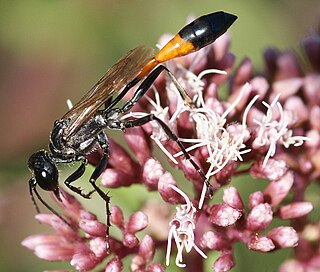
Ammophila sabulosa, the red-banded sand wasp, is a species of the subfamily Ammophilinae of the solitary hunting wasp family Sphecidae, also called digger wasps. Found across Eurasia, the parasitoid wasp is notable for the mass provisioning behaviour of the females, hunting caterpillars mainly on sunny days, paralysing them with a sting, and burying them in a burrow with a single egg. The species is also remarkable for the extent to which females parasitise their own species, either stealing prey from nests of other females to provision their own nests, or in brood parasitism, removing the other female's egg and laying one of her own instead.
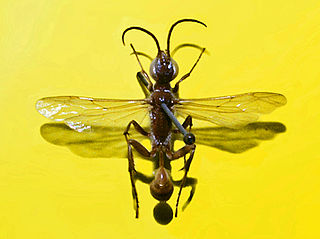
Chalybion flebile is a species of mud dauber wasps belonging to the family Sphecidae.

Tachytes is a genus of predatory, solitary wasps, containing about 300 species.
Ampulex ferruginea is a species of cockroach wasp in the family Ampulicidae.

Ammophila placida is a species of thread-waisted wasp in the family Sphecidae. It is found in the continental United States and Central America.

Ammophila aberti is a species of thread-waisted wasp in the family Sphecidae.
Dolichurus greenei is a species of cockroach wasp in the family Ampulicidae.
Ampulex canaliculata is a species of cockroach wasp in the family Ampulicidae.

Palmodes occitanicus is a species of thread-waisted wasp in the family Sphecidae.

Sceliphron asiaticum is a species of thread-waisted wasp in the family Sphecidae. It is native to the Neotropics, South America and the Caribbean region.
